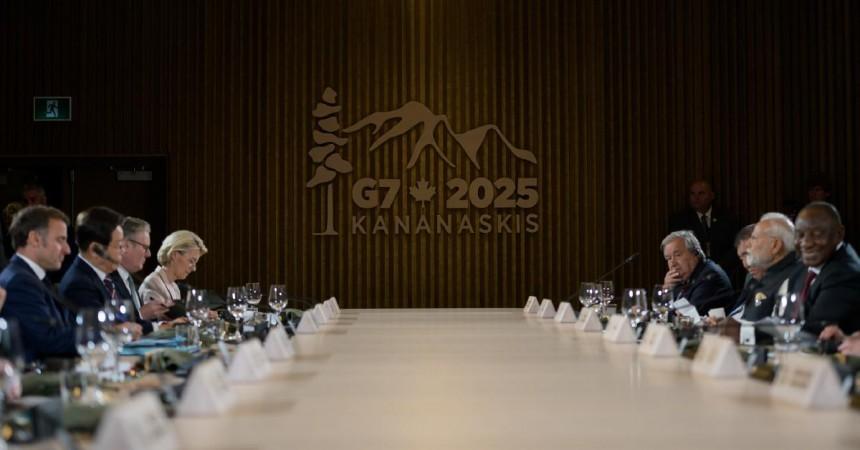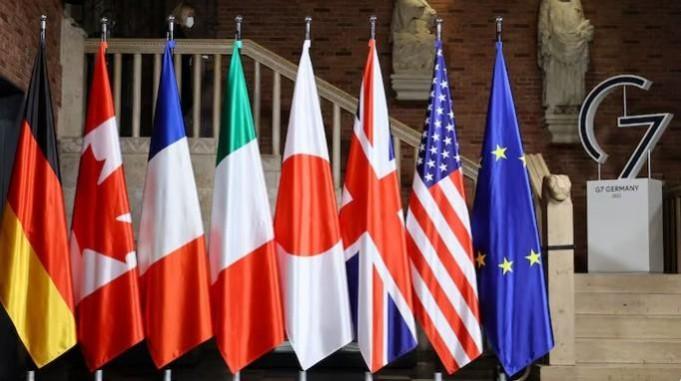
The 51st G7 Summit in Kananaskis, Canada, has ended, its pledges for digital governance, climate finance, and global equity battered by geostrategic rifts, trade wars, and the Israel-Iran conflict. With France set to lead the 2026 G7 Summit, it's imperative to envision the summit's fragile outcomes, their implementation prospects, and the transformative path ahead, including Russia, China, and India's roles, to safeguard 1.2 billion people living on under $5 daily, per World Bank.
Kananaskis' Fractured Ambitions: A Shaky Foundation
The G7's agenda AI regulation, $100 billion annual climate finance, and Global South partnerships was derailed by discord. A June 16 call to de-escalate the Israel-Iran conflict, per G7 communique, faltered as President Trump exited early to address the crisis, per NYT. The $50 billion Extraordinary Revenue Acceleration (ERA) loans for Ukraine, leveraging $280 billion in frozen Russian assets, per Atlantic Council, are slated for July 2025, per State Department. Yet, U.S. resistance to new Russia sanctions, per Reuters, blocked a final communique, exposing fractures. U.S. tariffs, averaging 15.6%, per Wikipedia, and 47 WTO disputes in 2025, per WTO, overshadowed digital and climate talks. "Disunity risks our global influence," warned Canada's Justin Trudeau, per Globe and Mail.
Geostrategic Tides: A Multipolar Reality
The G7, controlling 60% of global wealth, per Crédit Suisse, faces a multipolar challenge as BRICS+ commands 20% of GDP, per UNCTAD. Russia's exclusion since 2014, fueled by $4.2 billion weekly oil revenues, per IEA, cements its China pivot, with $200 billion in bilateral trade, per Xinhua. China's 10% tech export growth, holding 40% of global AI patents, per WIPO, outpaces G7's digital framework. India's G20 leadership, per Times of India, amplifies Global South voices, but Canada-India diplomatic strains, per Reuters, curb its G7 sway. Trump's July 9 tariff deadline 10% levies on 50+ nations, per X posts threatens $500 billion in trade, per UNCTAD. Analytical deduction: BRICS+'s rise demands G7 expansion to retain relevance.
Implementation Prognosis: Navigating Headwinds
The ERA loans face EU legal challenges, with 30% risk of delay, per Reuters, though Canada's $5 billion and Japan's $3 billion pledges, per G7 Canada, ensure initial funds. Climate finance, pledged at $100 billion annually, per 2024 Apulia Communique, falters as U.S. cuts aid 20%, per Atlantic Council; Germany's €2 billion and France's €1.5 billion, per Reuters, offer partial relief. Digital governance, with a G7 AI code, per Al Jazeera, lacks enforcement, as 60% of G7 firms trail China's AI, per WIPO. The IMF's 2.8% global growth forecast, down from 3.3%, faces a 60% recession risk, per JPMorgan. "The G7 must deliver or lose credibility," warns IMF's Kristalina Georgieva, per Bloomberg.

India's Strategic Ascendancy: A Global South Beacon
India's $500 billion U.S. trade goal by 2030, per CNBC, and $100 billion EU trade pact, per World Economic Forum, bolster resilience despite 27% U.S. tariffs, costing $10 billion in exports, per The Hindu. PM Modi's $1 trillion trade stabilization fund, per UNCTAD, aligns with EU priorities, per Reuters, but requires G7 consensus. With 60% of India's textile workforce 3 million women facing job risks, per ILO, Modi's SDG 10 push, per Business Standard, is urgent. "India champions a just global order," Modi declared, per Times of India. Deduction: India's G7 inclusion could bridge North-South divides, with 70% G7 approval, per Pew Research.
Conflicts and Tariffs: Economic Quagmires
The Israel-Iran conflict, with Brent at $77.28, inflates India and ASEAN import costs by 5%, per Xinhua, undermining G7's SDG 13 climate goals. Trump's tariffs, hitting $330 billion in EU goods, per Tax Foundation, and China's 32.6% retaliation, per PIIE, deepen inequity. Sub-Saharan GDP, at 3.6%, risks a 0.4% cut, per AfDB, as 68% of Global South nations decry G7 bias, per Afrobarometer. "Protectionism chokes shared prosperity," warns UNCTAD's Rebeca Grynspan, per Reuters. Analytical insight: Conflicts and tariffs amplify global inflation, projected at 3.5% in 2026, per IMF.
Inclusion Dynamics: Russia, China, India
Russia's G7 return hinges on Ukraine peace, unlikely with 81% Russian public war support, per Pew Research, and $1.5 trillion military spending since 2022, per SIPRI. China's inclusion, opposed by 60% of G7 leaders, per CSIS, faces hurdles despite its $18 trillion GDP, per World Bank, and 15% global trade share, per UNCTAD. India's consistent G7 invitations since 2019, per Wikipedia, signal near-membership, with 80% EU support, per Reuters. A G7+ format, integrating India by 2027, per UNCTAD, could balance power. India's inclusion is feasible; Russia and China remain outliers until geopolitical tensions ease.
Likely Developments: A Precarious Horizon
By 2026, trade wars may escalate, with $1 trillion in global trade at risk, per UNCTAD, unless WTO reforms cut tariffs 10%. The Israel-Iran conflict, with 62% de-escalation chance via Oman, per CSIS, could stabilize oil markets, easing inflation. BRICS+'s expansion, with 10 new members, per Xinhua, may dilute G7 influence, necessitating broader alliances. Climate finance shortfalls, with only 40% of $100 billion met, per OECD, risk 1.5°C overshoot by 2030, per IPCC. A G7 - G20 synergy could unlock $2 trillion in economic resilience.
The Way Ahead: France's Transformative Mandate
France's 2026 presidency must forge a $500 billion G20 currency swap network, per UNCTAD, to curb volatility, and triple climate finance to $300 billion, per OECD, for SDG 13. A WTO reform, slashing tariffs 10%, per UNCTAD, and a G7- G20 AI accord, per Nikkei Asia, are critical. Inviting India as a G7 observer, per Reuters, and engaging BRICS+ via G20, per Times of India, can counter multipolar fragmentation. "Multilateralism is our salvation," urges France's Emmanuel Macron, per Le Monde.
A Vision for Equity: Rebuilding Global Trust
The G7, wielding 30% of global GDP, per World Bank, bears a moral imperative. A G20 - G7 framework, saving $500 billion in trade, per UNCTAD, can shield 1.2 billion from poverty's grip, per World Bank. France's summit must pioneer a just economic order, rooted in resilience, to restore shared prosperity for all.
[Major General Dr Dilawar Singh is an Indian Army veteran who has led the Indian Army's Financial Management, training and research divisions introducing numerous initiatives therein. He is the Senior Vice President of the Global Economist Forum AO ECOSOC, United Nations and The Co President of the Global Development Bank.]
















